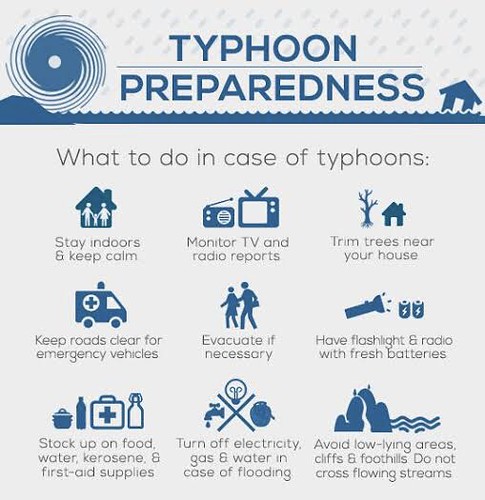Before a typhoon hits
To prepare for a Typhoon, you should take the following measures:- To begin preparing, you should build an emergency kit and make a family communications plan.
- Know your surroundings.
- Learn the elevation level of your property and whether the land is flood-prone. This will help you know how your property will be affected when storm surge or tidal flooding are forecast.
- Identify levees and dams in your area and determine whether they pose a hazard to you.
- Learn community Typhoon evacuation routes and how to find higher ground. Determine where you would go and how you would get there if you needed to evacuate.
- Make plans to secure your property:
- Cover all of your home’s windows. Permanent storm shutters offer the best protection for windows. A second option is to board up windows with 5/8” marine plywood, cut to fit and ready to install. Tape does not prevent windows from breaking.
- Install straps or additional clips to securely fasten your roof to the frame structure. This will reduce roof damage.
- Be sure trees and shrubs around your home are well trimmed so they are more wind resistant.
- Clear loose and clogged rain gutters and downspouts.
- Reinforce your garage doors; if wind enters a garage it can cause dangerous and expensive structural damage.
- Plan to bring in all outdoor furniture, decorations, garbage cans and anything else that is not tied down.
- In a strong typhoon, A LOOSE OBJECT IS A MISSILE!
- Determine how and where to secure your boat.
- If in a high-rise building, be prepared to take shelter on or below the 10th floor.
During a Typhoon
If a Typhoon is likely in your area, you should:
- Listen to the radio or TV for information.
- Secure your home, close storm shutters and secure outdoor objects or bring them indoors.
- Turn off utilities (electricity) if instructed to do so. Otherwise, turn the refrigerator thermostat to its coldest setting and keep its doors closed.
- Turn off LPG tanks
- Avoid using the phone, except for serious emergencies.
- Moor your boat if time permits.
- Ensure a supply of water for sanitary purpose such as cleaning and flushing toilets. Fill the bathtub and other larger containers with water.
- Find out how to keep food safe during and after and emergency.
You should evacuate under the following conditions:
- If you are directed by local authorities to do so. Be sure to follow their instructions.
- If you live in a weak home or temporary structure – such shelter are particularly hazardous during Typhoon no matter how well fastened to the ground.
- If you live in a high-rise building – Typhoon winds are stronger at higher elevations.
- If you live on the coast, on a floodplain, near a river, or on an island waterway.
Read more about evacuating yourself and your family. If you are unable to evacuate, go to your wind-safe room. If you do not have one, follow these guidelines:
- Stay indoors during the Typhoon and away from windows and glass doors.
- Close all interior doors – secure and brace external doors.
- Keep curtains and blinds closed. Do not be fooled if there is a lull; it could be the eye of the storm – winds will pick up again.
- Take refuge in a small interior room, closet or hallway on the lowest level.
- Lie on the floor under a table or another sturdy object.
- Avoid elevators.







No comments:
Post a Comment
Note: Only a member of this blog may post a comment.